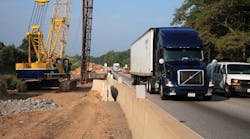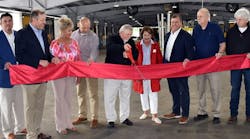Competing funding proposals from President Obama and Congress plus a looming July deadline for the highway trust fund (HTF) to run out of money married to a legislative process that isn’t designed for speed are just some of the factors complicating efforts to set federal transportation strategy on a steady multi-year course for the future.
“I’ve never a scenario like this before,” James Burnley, who co-chairs the transportation practice at law firm Venable LLP in Washington D.C. and served as U.S. Secretary of Transportation from 1987 to 1989, told Fleet Owner.
“We’ve had [funding] extensions in the past but the signal from Speaker [John] Boehner [R-OH] is that such an extension won’t happen this time.” Burnley said. “I attach great significance to that because now it means the funding issues must be dealt with and finished now, in the next few months. On top of that, both parties are not in favor of fuel tax increases. So now we’re in a situation where they’ve all got to come together quickly to approve a different funding approach. In 30 years I’ve never seen a situation like this.”
The U.S. Department of Transportation (DOT) recently updated its HTF “ticker” to show that the surface transportation program continues to outlay monies at a greater pace than receipts are coming in. As a result, the HTF’s cash balance dropped by nearly $3.3 billion since a $9.7 billion transfer from the federal government’s general revenue fund occurred in February – a transfer authorized in the MAP-21 highway bill that expires in September.
“The HTF is on a path to insolvency well before the end of the current [federal govt.] fiscal year and that’s a scary thought,” Bud Wright, executive director for the American Association of State Highway and Transportation Officials (AASHTO) told Fleet Owner.
“Two things will happen if the HTF runs out of money,” he explained. “States must pay contractors working on highway projects with their own funds or contractors go unpaid. This is a situation that is extremely rare; we’ve never faced something like this before.”
While Wright feels it is highly unlikely current work will go unpaid, not stabilizing the HTF and not crafting a multi-year highway bill will severely crimp efforts to expand and improve U.S. transportation infrastructure going forward.
“We won’t drop off a ‘fiscal cliff’ as it were; current projects will most likely keep going,” he emphasized. “But no new projects will be started. Some states can do it but most cannot without federal funding – and federal funding accounts for half of all highway infrastructure investments.”
Two longer-term issues from AASHTO’s point of view revolving around the funding stalemate regards the age of the highway system as a whole – over 50-plus years since President Eisenhower’s administration established it – and the need for what the group calls “funding certainty.”
“We’re at a point where the many roads and bridges have reached their designed life – they need significant repairs or replacement,” Wright said. “Then you need to look at highway construction and contracting firms: they need to make investments in equipment and personnel to perform such work. And if a stable source of federal funding isn’t there for four or more years, maybe they don’t make those investments. They need to see a firm vision for where the country is going with transportation infrastructure and the funding to get there.”
Terry O’Sullivan, general president of the Laborers’ International Union of North America, characterized the issue in much starker terms in a statement released earlier this month.
“The duct-tape approach Congress has taken in the past to our transportation infrastructure crisis has resulted in a fourth of our bridges becoming deficient or obsolete while our roadways are congested, pot-hole ridden and falling apart,” he said. “The average bridge in our country is 45 years old, dangerously close to the average 50-year lifespan and, typically, 25 bridges a year collapse in the U.S.”
Venable’s Burnley noted, though, that the legislative process required to get such “funding certainty” established must pass through several Congressional conduits – a process that by its very design is anything but fast.
He stressed that while President Obama’s administration can offer funding solutions, as can Sen. Barbara Boxer (D-CA) and Rep. Bill Shuster (R-PA), respectively chair of the Environment and Public Works committee and chairman of the Transportation and Infrastructure committee, the actual money for any proposal must come from the House of Representatives Ways and Means committee, where Rep. Dave Camp (R-MI) – that committee’s chairman – recently proposed in draft tax reform legislation dubbed the “Tax Reform Act of 2014” that $126.5 billion be dedicated to the HTF for highway investments over the next eight years.
Getting all of those parties to agree on a final legislative package – much less getting any such package passed by Congress as a whole – in just a few months is a tall order, in Burnley’s view.
“Over the last five years Congress has been willing to transfer money from the general fund – some $54 billion and counting – but it’s very significant when the Speaker says that basically happen anymore,” he explained.
Indeed, Speaker Boehner told Reuters that a bailout for the highway fund likely would be out of the question for his caucus. “We've got to find a funding mechanism to fund our infrastructure needs," he said back in February. “I wish I could report to you that we've found it, but we haven't.”
And that sends the debate over U.S. transportation funding into what Venable’s Burnley characterizes as “uncharted territory.”
“It’s not like we’ll immediately go over a funding cliff but we will get very close to the edge of one if a bill isn’t put together and passed,” he said. “The flow of [federal] funds will dramatically drop, meaning DOT will write far fewer and smaller checks if something isn’t done.”



